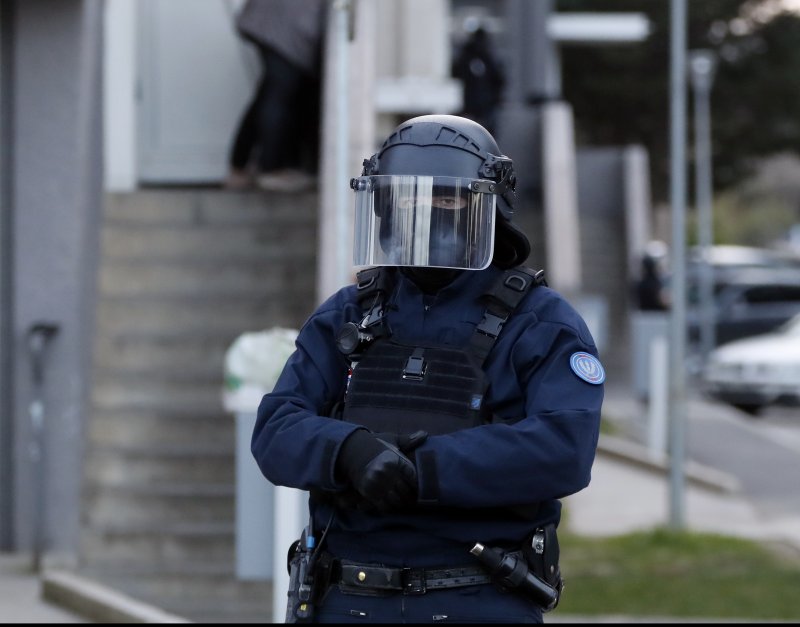French police secure a perimeter during a raid at the apartment of Redouane Ladkim in Carcassonne, France, on March 23. Photo by Guillaume Horcajuelo/EPA-EFE
April 2 (UPI) -- The rampage by Moroccan-born French national Redouane Lakdim in Carcassonne, France, is being called a jihadist outrage but it is really France's equivalent of school shootings in the United States.
Both kinds of attacks are generally carried out by disaffected young men with access to firearms. Both have become so repetitive they quickly drop out of world headlines after teary public tributes and customary chest-thumping by politicians. Both sorts of attacks are random and their perpetrators operate just below the radar until the mayhem.
Many of the murderous attacks in France and the United States are followed by revelations of law enforcement misses and a string of "what if" questions. What if police and health workers in Florida had acted on the disturbing trail of clues left by the Valentine's Day school shooter Nikolas Cruz? What if French security services had not been quite so relaxed about Lakdim, who was on an extremist watch list?
Such questions are a natural response to an atrocity but the most comprehensive security and mental health regime in the world cannot stop the kind of attacks undertaken by Cruz and Lakdim. For that, a wider systemic shake-up would be needed.
In the United States, it would mean common sense gun control, preceded by a political tectonic shift in attitude. In France, which suffered three big terrorist attacks in 2015 and 2016 and a series of minor ones, the political response would need to be equally far-reaching.
There would have to be a willingness to tackle what geographer Christophe Guilluy calls "peripheral France." That includes the banlieues, where second-generation non-European Frenchmen and women live on the outermost margins of society. A sizable number of banlieue residents are from Algeria, Morocco and sub-Saharan Africa, so much so that the localities are often described as Muslim ghettos with all the attendant implications for opportunity and social mobility.
There is also the banlieue bubble, not a physical but a mental space occupied by non-European naturalized townies such as Lakdim. As French Interior Minister Gerard Collomb said of the 25-year-old dual national who dabbled in drug dealing and broke the law in myriad other small ways, it's not clear if Lakdim was a committed Islamist radical or "more of a petty criminal who at a certain moment decided to act."
That sounds about right. French political scientist Olivier Roy has repeatedly warned against drowning "jihadism in Salafism" and criminal attacks in Islamism because that ignores the sociological roots of radicalization. "The establishment of an Islamist society does not interest" those who kill and maim in the name of Islam, says Roy, though "they are part of an Islamic narrative construction."
Indeed, the supposedly explanatory link to Islamism in the case of Lakdim's March 23 attack is so easy and opportunistic as to be almost meaningless.
Much is made of Lakdim's ethnicity as a red flag, for Moroccans were a substantial subset of foreign fighters and dual Moroccan-European citizens involved in the Islamic State attacks on Paris and Brussels in 2015 and 2016. Much is also made of Lakdim's religiosity, something that is generally manifest by such mass murderers in being "very active" on online jihadi forums.
To have been born in Morocco is hardly a crime and the security services never judged Lakdim's Internet radicalism serious enough to constitute a threat to the public.
In any case, Lakdim was just one of nearly 20,000 people registered with France's Terrorism Prevention and Terrorism Reporting Files, of whom approximately half are under constant surveillance. That suggests impossibly long odds for identifying -- and stopping -- prospective Lakdims. Or school shooters like Cruz in the United States.
Roy, who published Jihad and Death: The Global Appeal of Islamic State last year, reframes the problem, recognizing it for what it is. He says the phenomenon of murderous attacks in France and elsewhere in Europe may be better understood and tackled by comparison with similar "suicidal behavior" by perpetrators of U.S. school shootings.
"There have been 50 Columbines since 1999... death is part of their project... There is no propaganda [for France's killers and U.S. shooters] except by action," he says.
And no particular cause either, except the action.
This article originally appeared at The Arab Weekly.















